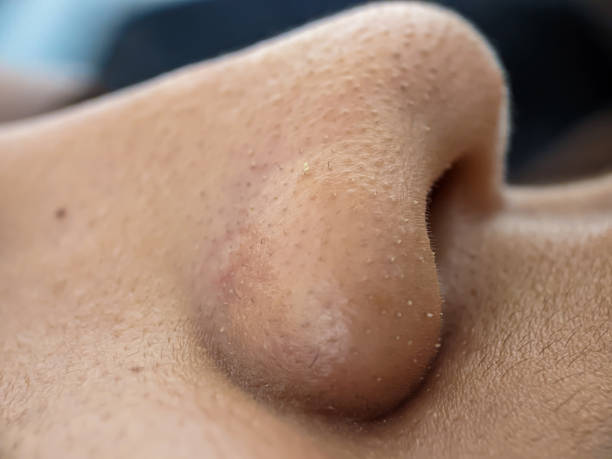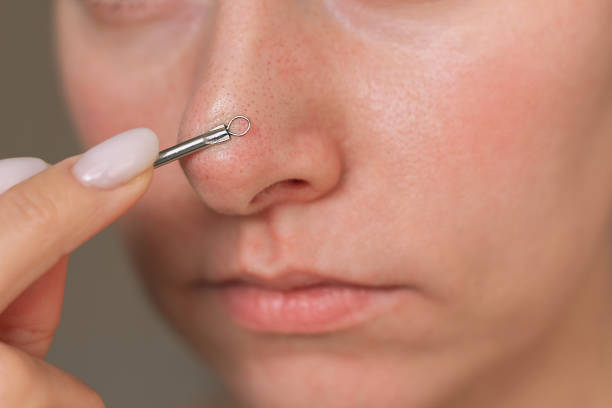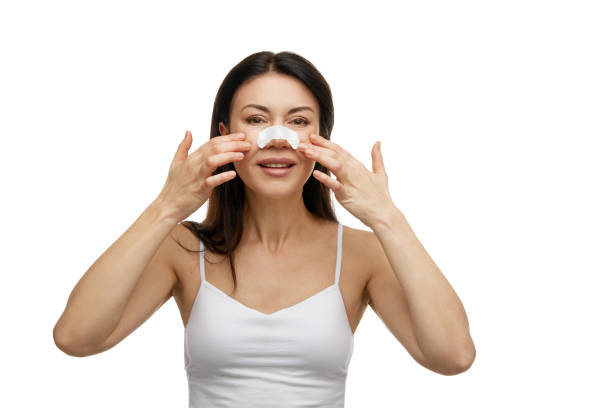Blackheads, medically known as open comedones, are a common type of acne that affects people of all ages, though they are particularly prevalent during adolescence and young adulthood. They appear as small, dark spots on the skin, primarily on the face, neck, back, and shoulders. The dark color of blackheads is not due to dirt but rather the oxidation of melanin when the pore is exposed to air. Blackheads form when hair follicles become clogged with dead skin cells, oil (sebum), and other debris. Unlike whiteheads, which are closed comedones, blackheads have an open surface, allowing the contents to undergo oxidation, which gives them their characteristic dark appearance.
Understanding the causes and mechanisms of blackhead formation is crucial for effective prevention and treatment. Various factors contribute to their development, including hormonal changes, excessive oil production, and certain lifestyle habits. While blackheads are generally harmless, they can be aesthetically displeasing and may lead to more severe acne if not managed properly. This introduction aims to explore the nature of blackheads, their underlying causes, and the most effective ways to prevent and treat them, promoting clearer and healthier skin.
Table of Contents
What Do Blackheads Look Like?

Blackheads are easily recognizable due to their distinctive appearance. They manifest as small, dark spots on the skin, primarily found in areas with high oil gland activity such as the face, neck, back, chest, and shoulders. Here are some key characteristics of blackheads:
- Color: Blackheads appear dark brown or black on the skin. This coloration is not due to dirt, but rather the result of the oxidation of melanin, the pigment produced by skin cells, when it comes into contact with air.
- Size: Blackheads are typically small, usually less than 2 millimeters in diameter. However, their size can vary depending on the severity of the clogging and the individual’s skin type.
- Texture: On touch, blackheads may feel slightly raised above the surface of the skin. Unlike pimples, blackheads are not inflamed and do not have a surrounding area of redness or swelling.
- Shape: Blackheads often have a flat appearance because they do not have a closed surface, making them different from other types of acne such as whiteheads or cysts, which are enclosed and more protruding.
- Location: Commonly found in the T-zone of the face (forehead, nose, and chin), blackheads can also appear on other parts of the body, particularly areas prone to oiliness and larger pores.
Understanding these characteristics can help in identifying blackheads and distinguishing them from other skin issues, enabling more targeted and effective skincare treatments.
Causes of Blackheads

Blackheads form when hair follicles become clogged with a combination of dead skin cells, oil (sebum), and other debris. Several factors contribute to the development of these open comedones, including:
- Excessive Sebum Production: The sebaceous glands produce oil to keep the skin moisturized. However, overproduction of sebum can lead to clogged pores, creating an environment conducive to blackhead formation.
- Hormonal Changes: Hormonal fluctuations, particularly during puberty, menstruation, pregnancy, or due to the use of birth control pills, can increase oil production in the skin. Androgens, male hormones present in both men and women, play a significant role in stimulating the sebaceous glands.
- Dead Skin Cells: The natural shedding of dead skin cells can sometimes accumulate and mix with sebum, blocking hair follicles. This mixture can form a plug that leads to blackheads.
- Cosmetic Products: Certain makeup, skincare, and hair products can contribute to the clogging of pores. Products that are oil-based or comedogenic (pore-clogging) are particularly problematic.
- Improper Skincare Routine: Inadequate cleansing, exfoliating, or using harsh skincare products can disrupt the skin’s natural balance. Not removing makeup properly before sleeping can also lead to clogged pores.
- Environmental Factors: Pollution, high humidity, and sweating can contribute to the buildup of dirt and oil on the skin, increasing the likelihood of blackheads.
- Diet: While the relationship between diet and acne is still being studied, some evidence suggests that a diet high in refined sugars and dairy products may exacerbate acne conditions, including blackheads.
- Genetics: A predisposition to developing blackheads and other forms of acne can be inherited. If your parents had acne-prone skin, you are more likely to experience similar issues.
- Medications: Certain drugs, such as corticosteroids, lithium, or androgens, can increase the risk of developing acne and blackheads.
Understanding these causes can help in adopting preventive measures and choosing appropriate treatments to manage blackheads effectively.
How to Get Rid of Blackheads

Getting rid of blackheads involves a combination of proper skincare practices, over-the-counter treatments, and professional interventions. Here are some effective methods:
- Regular Cleansing: Wash your face twice daily with a gentle cleanser to remove excess oil, dirt, and makeup. Avoid harsh soaps that can irritate the skin and lead to more oil production.
- Exfoliation: Use a mild exfoliant containing alpha hydroxy acids (AHAs) or beta hydroxy acids (BHAs) to remove dead skin cells and prevent clogged pores. Salicylic acid is particularly effective for penetrating and cleaning out pores.
- Topical Treatments: Apply over-the-counter products containing benzoyl peroxide, salicylic acid, or retinoids. These ingredients help to unclog pores, reduce oil production, and promote skin cell turnover.
- Clay Masks: Use clay masks once or twice a week to absorb excess oil and draw out impurities from the pores. Bentonite or kaolin clay masks are particularly beneficial.
- Pore Strips: Pore strips can provide a temporary solution by physically removing blackheads from the surface of the skin. However, they do not prevent new blackheads from forming.
- Non-comedogenic Products: Choose skincare and makeup products labeled as non-comedogenic, meaning they are less likely to clog pores.
- Professional Treatments:
- Facials: Regular facials by a licensed esthetician can help deeply cleanse and exfoliate the skin. Extraction techniques used during facials can effectively remove blackheads.
- Chemical Peels: Professional chemical peels use stronger acids to exfoliate the skin and remove dead skin cells, reducing the formation of blackheads.
- Microdermabrasion: This treatment involves using a special device to exfoliate the top layer of skin, helping to clear clogged pores and improve skin texture.
- Laser Therapy: Laser treatments can reduce oil production and minimize the appearance of pores, helping to prevent blackheads.
- Healthy Lifestyle: Maintain a balanced diet, stay hydrated, and manage stress levels to support overall skin health. While the direct impact of diet on blackheads is still under study, a healthy lifestyle can contribute to better skin.
- Avoid Squeezing: Resist the temptation to squeeze or pick at blackheads, as this can lead to inflammation, scarring, and further skin issues.
By incorporating these practices into your skincare routine, you can effectively manage and reduce the occurrence of blackheads, achieving clearer and healthier skin.
Preventing Blackheads

Preventing blackheads involves adopting a consistent skincare routine and making lifestyle choices that minimize the factors contributing to clogged pores. Here are some strategies to help prevent blackheads:
- Daily Cleansing: Cleanse your face twice daily with a gentle, non-comedogenic cleanser to remove excess oil, dirt, and impurities. Make sure to cleanse after sweating, as sweat can mix with oil and dirt, leading to clogged pores.
- Exfoliate Regularly: Exfoliate your skin 2-3 times a week using products containing alpha hydroxy acids (AHAs) or beta hydroxy acids (BHAs). These ingredients help remove dead skin cells and keep pores clear. Avoid over-exfoliating, which can irritate the skin and increase oil production.
- Use Non-Comedogenic Products: Choose skincare and makeup products labeled as non-comedogenic, meaning they are formulated to not clog pores. Avoid heavy, oil-based products that can contribute to blackhead formation.
- Moisturize: Use a lightweight, oil-free moisturizer to keep your skin hydrated without clogging pores. Even oily skin needs hydration to maintain a healthy balance.
- Sun Protection: Apply a broad-spectrum sunscreen daily. Sun damage can thicken the outer layer of skin, leading to clogged pores and blackheads. Choose a sunscreen that is non-comedogenic and suitable for your skin type.
- Avoid Touching Your Face: Refrain from touching your face frequently, as this can transfer dirt and oil from your hands to your skin, leading to clogged pores.
- Hair Care: Keep hair clean and away from your face. Hair products like gels, sprays, and oils can clog pores when they come into contact with your skin. Use non-comedogenic hair products when possible.
- Balanced Diet: Maintain a balanced diet rich in fruits, vegetables, and whole grains. Some studies suggest that diets high in refined sugars and dairy products may contribute to acne. Staying hydrated and eating a balanced diet can support overall skin health.
- Manage Stress: Stress can trigger hormonal changes that increase oil production, leading to blackheads and other types of acne. Practice stress-management techniques such as exercise, meditation, and adequate sleep to keep stress levels in check.
- Regular Facial Treatments: Consider professional facial treatments, such as chemical peels, microdermabrasion, or regular facials with extractions, to help maintain clear pores and prevent blackheads.
- Stay Consistent: Consistency is key in preventing blackheads. Stick to a regular skincare routine, and give products time to work. Avoid switching products too frequently, as this can irritate the skin and disrupt its balance.
By incorporating these preventive measures into your daily routine, you can reduce the likelihood of developing blackheads and maintain clearer, healthier skin.
Conclusion
Blackheads, though a common skin concern, can be effectively managed and prevented with the right approach. Understanding their causes, such as excessive oil production, hormonal changes, and improper skincare practices, is the first step towards addressing them. Adopting a consistent skincare routine that includes regular cleansing, exfoliation, and the use of non-comedogenic products can significantly reduce the occurrence of blackheads. Additionally, incorporating healthy lifestyle choices, such as a balanced diet and stress management, supports overall skin health and helps prevent blackheads from forming.
For those who struggle with persistent blackheads, professional treatments like facials, chemical peels, and laser therapy offer more intensive solutions. However, the key to long-term prevention lies in maintaining consistent skincare habits and making informed choices about the products and practices that best suit your skin type.
By combining these strategies, you can achieve clearer, healthier skin, free from the frustration of blackheads. Remember, while it may take time and patience, the results are worth the effort, leading to improved confidence and a more radiant complexion.
